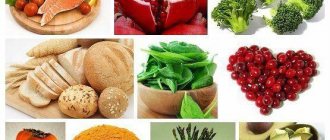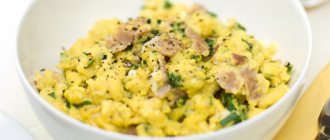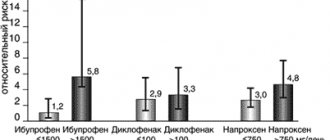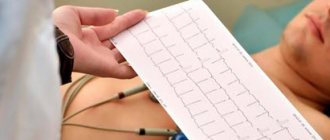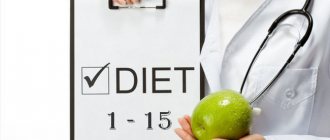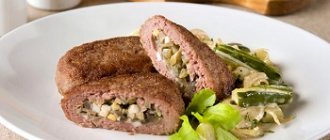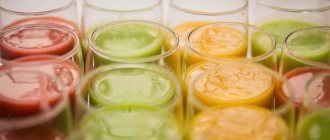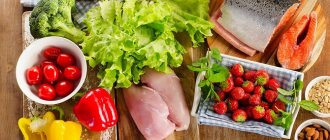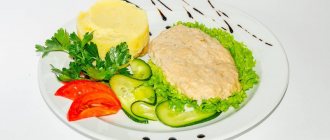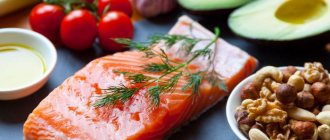Indications for use.
Therapeutic diet No. 10 according to Pevzner is recommended for people with diseases of the cardiovascular system with not pronounced circulatory failure. The diet is recommended for rheumatism and heart defects, hypertension, and coronary heart disease. In addition, this diet is useful for diseases of the nervous system, chronic nephritis and pyelonephritis with changes in urine sediment. Eating according to diet No. 10 helps improve blood circulation, the functioning of the cardiovascular system, kidneys, and liver, normalizes metabolism, and eases the load on the cardiovascular system and digestive organs.
Nutritional features.
A characteristic feature of this diet is the reduction in the amount of fats and carbohydrates in the diet . also significantly limit the amount of table salt, liquids and foods that stimulate the cardiovascular and nervous systems - strong tea, coffee, chocolate; irritate the liver and kidneys - spicy, fried, fatty foods; difficult to digest and can cause flatulence - beans, cabbage, mushrooms. At the same time, the diet is rich in foods that have an alkalizing effect on the body - fruits, vegetables, and seafood.
The recommended diet is 5-6 times a day, and dinner should be at least three hours before bedtime. All diet dishes are prescribed to be cooked without salt, and meat and fish must be boiled. Baking and light frying are also allowed.
Chemical composition and energy value.
Proteins – 90 g (of which 50 g are animal), fats – 65-70 g (of which 20 g are vegetable), carbohydrates – 350-400 g, table salt – up to 6-8 g. For cardiovascular diseases, the amount of free fluid limited to 1000-1200 ml.
The calorie content of the diet is 2350-2600 kcal.
| Product table | |
| Authorized products | Prohibited Products |
| Bread and bakery products | |
| Wheat bread made from 1st and 2nd grade flour, yesterday's baking or slightly dried, dietary salt-free bread, savory cookies and biscuits. | Fresh bread, butter and puff pastry products, pancakes, pancakes. |
| Milk and dairy products | |
| Milk, fermented milk drinks, cottage cheese and dishes made from it, low-fat unsalted cheese. | Salty and fatty cheeses. |
| Soups | |
| Vegetarian soups with various cereals, potatoes and vegetables, beetroot soups, you can add sour cream and herbs. Soups are recommended in quantities of 250-400 g per meal. | Soups with strong meat, fish and mushroom broths. |
| Meat and meat dishes | |
| Lean meat and poultry - beef, veal, trimmed pork, rabbit, chicken, turkey. After boiling, you can bake and fry, or make jellied dishes. Boiled sausages in limited quantities. | Fatty meats - duck, goose, pork, liver, kidneys, brains, sausages, any smoked meats, fried cutlets, chops, canned meat. |
| Fish and fish dishes | |
| Low-fat fish varieties. | Smoked and salted fish, canned fish, caviar. |
| Cereals and pasta | |
| Various cereals in the form of porridges, casseroles; boiled pasta. | |
| Vegetables | |
| Potatoes, carrots, beets, zucchini, pumpkin, tomatoes, lettuce, cucumbers. Vegetables should be boiled or raw. White cabbage and green peas are recommended to be eaten in limited quantities. Green onions, dill, parsley can be added to any dish. | Legumes, salted, pickled and pickled vegetables, spinach, sorrel, radish, radish, garlic, onions, mushrooms. |
| Eggs and egg dishes | |
| Soft-boiled eggs or baked omelettes, egg white omelettes, or added to dishes up to 1 piece per day. | Hard-boiled and fried eggs. |
| Fats | |
| Unsalted butter and ghee, vegetable oils in their natural form. | Meat and cooking fats. |
| Sauces and spices | |
| Sauces based on meat, fish, mushroom broth, mustard, horseradish, pepper. | |
| Berries and fruits | |
| Soft ripe fruits and fresh berries, dried fruits, compotes, jelly, mousse, jellies, milk jelly and creams. | Fruits with coarse fiber. |
| Sweets | |
| Honey, jam, not chocolates. | Chocolate. |
| Beverages | |
| Weak tea, coffee drinks, fruit and vegetable juices, rosehip infusion, limited grape juice. | Natural coffee and cocoa. |
Types of diet No. 10.
Nutritionists distinguish several types of this diet. Dietary table No. 10a is recommended for heart disease with circulatory failure stage II-III, essential arterial hypertension with circulatory failure, and myocardial infarction in the acute or subacute period. This diet is characterized by a protein content at the lower limit of the physiological norm, and fats and carbohydrates should be in moderation. The diet fully provides the body with vitamins C, P, PP, B. Allowed and prohibited foods are the same as with the general diet No. 10, except that the amount of bread is reduced to 150 g per day, a serving of soup is up to 200 ml or is excluded completely , and also excludes cheese, millet, barley and pearl barley.
Table No. 10b is recommended for rheumatism in circulatory disorders, for rheumatism in an inactive form and at the attenuation stage. This diet is high in protein and limited in easily digestible carbohydrates. Allowed and prohibited products completely coincide with the rules of the general table No. 10. In this case, vegetables are boiled or served raw, and dishes should be at normal temperature.
Table 10c is recommended for atherosclerosis of the vessels of the heart, brain, coronary disease, hypertension against the background of atherosclerosis. This is a dietary diet with limited salt and fat in the diet. Animal fats are replaced with vegetable fats as much as possible. Be sure to include foods rich in ascorbic acid, B vitamins, potassium and magnesium salts into the diet. Plenty of seafood is also beneficial. Culinary processing of dishes, diet and restrictions are maintained in accordance with basic diet No. 10.
Table No. 10g is indicated for essential arterial hypertension. This is a salt-free diet. The diet provides for a high content of ascorbic acid, thiamine, riboflavin, vitamin P, magnesium and potassium salts. And the diet includes foods rich in cell membranes, as well as seafood containing organic iodine, for example, seaweed.
Important Diet Elements
The daily menu of a patient with CHF must first of all be balanced with respect to proteins, fats, carbohydrates, cover energy costs, and be rich in microelements important for the heart.
Squirrels. An important structural element of cells. It is recommended to eat 2-3 servings of protein daily.
Equivalent to one serving:
- 100 grams of fish, meat (lean beef, veal, poultry);
- ? cups of boiled beans or peas;
- 1 egg.
It is necessary to limit proteins in the diet only in case of renal failure and azotemia.
Dairy products. The optimal amount is 2-3 servings:
- 100 grams of cottage cheese;
- 1 glass of milk with 1-2% fat content;
- 1 glass of kefir, fermented baked milk, yogurt, yogurt without additives;
- 2 tbsp. l. sour cream with a fat content of no more than 15%.
Vegetables and fruits. This is an important part of the diet, which provides the body with fiber, pectin, microelements, vitamins and is low in calories.
You need to eat 5 servings per day:
- ? cups chopped fruit (fresh or baked);
- ? cups of boiled or baked vegetables.
Porridge and bread . This part of the diet is responsible for energy saturation of the body. Preference should be given to slow carbohydrates, eating 5 servings daily:
- 1 slice of whole grain bread;
- ? cups of pasta;
- ? cups of rice, buckwheat, oatmeal and other cereals.
Unsaturated fats and oils. The body needs to get the “right” fats, as this is the building material of all cell membranes. For cooking and dressing salads, it is optimal to use refined oils (olive, corn, sunflower, flaxseed).
A good source of healthy fats are nuts (dried, unseasoned). You can consume 1 handful (40 grams) per day.
To give food a brighter taste, salt can be replaced with aromatic herbs (parsley, basil, oregano, rosemary, cumin, cilantro), garlic, onion, lemon juice, paprika.
Patients with atherosclerosis should pay special attention to the amount of dietary fiber in the diet (as they prevent the absorption of fatty acids from the intestine). Men need 76 grams per day, and women – 28 grams.
Also, if it is impossible for my patients to fully saturate their diet with the necessary vitamins and microelements, I recommend taking courses of beekeeping products and nutritional supplements enriched with potassium, magnesium, zinc, calcium, phosphorus (vitamins A, C, E, B1, B2, B6).
Regarding temperature treatment: it is better to boil, stew or bake foods for heart failure. Cooking on a grill and in a Teflon-coated frying pan is allowed, without oil.
Sample diet menu No. 10.
- First breakfast: soft-boiled egg, milk oatmeal, tea.
- Second breakfast: baked apples.
- Lunch: vegetable soup with vegetable oil (1/2 serving). Boiled meat with carrot puree, dried fruit compote.
- Afternoon snack: rosehip decoction.
- Dinner: curd pudding (1/2 serving), boiled fish with boiled potatoes, tea.
- At night: kefir.
A medical diet is prescribed only by the attending physician , who has full knowledge of the medical history of a particular patient.
Clinical case
My patient N. is 64 years old.
History of hypertension stage III, 2nd degree. In 2015, he suffered an acute Q-myocardial infarction of the anterior wall of the left ventricle, complicated by cardiogenic pulmonary edema. At the time of the first visit in 2021, the patient complained of shortness of breath, worsening with physical exertion, rapid heartbeat, and swelling in the legs. Objectively: N. had class I. obesity (BMI - 34.4 kg/m2), blood pressure - 145/100 mm. rt. Art., heart rate - 89 beats/min. According to the examination results, hypercholesterolemia, hypokinesia of the anterior wall of the left ventricle, ejection fraction 40%. The patient constantly took Enap N, Concor, Furosemide, Cardiomagnyl, and drank Nitroglycerin during attacks. A diagnosis was made: CHF IIA, IIFC. It was recommended to adjust the lifestyle, give up tobacco and alcohol, and select a diet for heart failure for every day. Over the course of 2 years, the patient gradually adapted to the new diet. At the last appointment: BMI - 28.9 kg/m2, blood pressure - 136/85 mm. rt. Art., heart rate - 79 beats/min. Complaints of shortness of breath have decreased; episodes of using Nitroglycerin are no more than once a week. The patient notes a significant increase in physical activity. Based on the results of the consultation, Fr.
From the list, the patient selects 3 main meals and 2-3 snacks.
Breakfast
- Oatmeal, buckwheat, corn, rice porridge, 40 grams, cooked in milk and water in a 1:1 ratio with 1 tsp. honey, 1 boiled egg, herbal tea.
- Omelette of 2 eggs with milk 1-2% (100 ml), a slice of whole grain bread, an apple, tea.
- 300 grams of pumpkin-rice (or millet) pudding, 30 grams of hard cheese.
- 200 grams of cheesecakes with berries and 1 tbsp. l. sour cream or honey, cocoa and low-fat milk.
- Oatmeal pancake with 2 tbsp. l. oatmeal, 1 egg with 30 grams of hard cheese, fresh cucumber, tea.
- Vegetable muffins with green peas, green beans and bell peppers, tea.
Lunches
- Vegetable puree soup (300 grams), 100 grams of boiled meat, 1 slice of bread.
- Lenten borscht (300 grams), 100 grams of stewed or baked poultry, a slice of bread.
- Vegetable salad with vegetable oil, steamed cutlet with a side dish of porridge, compote.
- 100 grams of pasta with vegetable sauce, 100 grams of meat, fresh vegetables.
- Lentil soup, 300 grams, 100 grams of baked fish with vegetables.
Dinners
- 200 grams of baked fish with vegetable garnish.
- Peppers, eggplants or zucchini stuffed with chicken and baked in the oven.
- Vegetable salad with squid with lemon-mustard dressing, 1 slice of whole grain bread with 30 grams of cheese.
- Salad of boiled beans with vegetables, seasoned with vegetable oil or yogurt with herbs, whole grain bread.
- Vinaigrette with beans, dressed with olive oil.
- Steamed poultry cutlets with stewed cabbage.
- Baked potatoes in their skins with a sauce based on yoghurt, herbs and garlic with vegetable salad.
- Omelet with green beans, fresh vegetables.
Snacks
- A handful of dried nuts.
- Apple baked in the oven with honey, cinnamon and cottage cheese.
- 100 grams of cottage cheese and 100 ml of fermented baked milk or 1 tbsp. l. sour cream.
- 1 banana, apple or pear.
- 1 cup chopped fruit.
- 200-250 ml of fermented milk drink.
- A slice of bread with 30 grams of cheese.
- 200 grams of milk pudding.
- 10 pieces. prunes or dried apricots.
- 1 handful of raisins.
- 1 glass of kefir, yogurt or fermented baked milk.
This “backbone” allows the patient to program a weekly menu, and over time, enter new recipes from the list of permitted products.
What's prohibited?
Article on the topic
Heart failure: causes, symptoms and emergency care
People with cardiovascular diseases or a tendency to them should completely avoid :
- products made from butter and puff pastry, cream products and ice cream;
- fatty varieties of meat, poultry and fish, including canned and salted ones, and do not use them for making soups;
- fatty or salty dairy products;
- products that can excite the nervous system, that is, strong tea, coffee, cocoa and chocolate;
- peas and beans;
- some vegetables, such as radishes, radishes, sorrel, spinach and mushrooms;
- marinades, meat, fish and mushroom sauces, pepper, mustard and caviar;
- alcoholic beverages and all carbonated drinks.
Reference
Atherosclerosis is a disease of blood vessels that lose flexibility as a result of harmful factors, become hard due to the deposition of fats on the walls and, as a result, narrow, which reduces blood access to organs. The disease leads to thrombosis and ischemic damage to organs. Atherosclerosis is considered one of the most dangerous diseases that leads to death.
